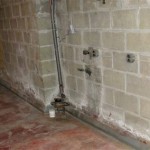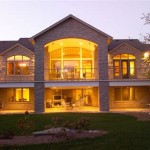How to Cover a Walkout Basement: A Comprehensive Guide
A walkout basement, characterized by one or more walls that open directly to the outside, offers unique advantages over traditional below-grade basements. This access allows for natural light, easier egress, and the potential for outdoor living spaces adjacent to the basement. However, effective coverage and finishing are crucial to maximizing the functionality and aesthetic appeal of a walkout basement while protecting it from the elements.
The specific approach to covering a walkout basement depends on several factors, including the desired aesthetic, budget constraints, and the local climate. This guide provides a comprehensive overview of various options and considerations for covering a walkout basement, addressing both structural and cosmetic aspects.
Addressing Water Management
Water management is paramount for any basement, but particularly crucial for walkout basements due to their direct exposure to the elements. Proper drainage systems are essential to prevent water from seeping into the basement and causing damage to the foundation and interior finishes.
The first step involves ensuring proper grading around the foundation. The ground should slope away from the house, directing rainwater and melting snow away from the basement walls. This grading minimizes the amount of water that can accumulate near the foundation.
In addition to grading, installing a perimeter drain, also known as a French drain, is highly recommended. This drain consists of a perforated pipe surrounded by gravel, buried along the foundation's exterior. The pipe collects groundwater and directs it away from the basement to a designated discharge point, such as a storm sewer or a dry well.
Downspouts from the roof should also be extended away from the foundation. Connecting downspouts to underground drainage pipes that lead to a discharge point further away from the house can significantly reduce the amount of water saturating the soil near the basement walls.
For walkout basements with sloped yards, consider incorporating retaining walls to manage soil erosion and direct water flow. Retaining walls prevent soil from sliding against the basement walls and help channel water away from the foundation.
Finally, ensure that any windows or doors leading into the walkout basement are properly sealed and flashed to prevent water infiltration. Regularly inspect these areas for cracks or damage and make necessary repairs promptly.
Exterior Wall Covering Options
The exterior walls of a walkout basement are constantly exposed to the elements, making the choice of covering material critical for both aesthetics and protection. Several options are available, each with its own advantages and disadvantages.
One common option is poured concrete. Concrete walls offer excellent durability and resistance to moisture. They can be painted or stained to match the rest of the house, or they can be left exposed for a more industrial look. However, concrete can be susceptible to cracking over time, requiring periodic maintenance and repair.
Another popular choice is concrete block. Concrete blocks are more affordable than poured concrete but require more labor to install. Like poured concrete, concrete blocks can be painted, stained, or faced with other materials. Proper waterproofing is essential when using concrete blocks, as they are more porous than poured concrete and can absorb moisture.
Siding, such as vinyl, wood, or fiber cement, can also be used to cover the exterior walls of a walkout basement. Siding provides a more finished look and can be matched to the siding on the upper floors of the house. When using siding, it is important to install a moisture barrier behind the siding to protect the underlying walls from water damage.
Stone veneer is another option that offers both aesthetic appeal and durability. Stone veneer can be applied directly to the concrete or concrete block walls, creating a realistic stone facade. Stone veneer is relatively low-maintenance and resistant to the elements.
Brick veneer is similar to stone veneer, offering a classic and durable finish. Brick veneer is available in a variety of colors and styles, allowing for customization to match the house's overall design. Brick veneer also requires proper installation and sealing to prevent moisture penetration.
When choosing an exterior wall covering, consider the local climate, the overall aesthetic of the house, and the budget. It is also important to consult with a qualified contractor to ensure proper installation and waterproofing.
Interior Finishing and Considerations
Once the exterior walls are covered and protected, attention can be turned to finishing the interior of the walkout basement. Interior finishing can transform a cold, damp space into a comfortable and functional living area.
The first step in finishing a walkout basement is to insulate the walls. Insulation helps to regulate the temperature, reduce energy costs, and prevent condensation. Options include fiberglass batts, spray foam insulation, and rigid foam insulation. Spray foam insulation provides the best air seal and is particularly effective in preventing moisture infiltration. Regardless of the insulation type chosen, a vapor barrier should be installed to further protect against moisture.
After insulation, framing is necessary to create interior walls. Wood framing is the most common option, but metal framing is also available. Framing should be properly aligned and securely attached to the floor and ceiling.
Once the framing is complete, drywall can be installed. Drywall provides a smooth surface for painting or other wall coverings. It is important to use moisture-resistant drywall in basements to prevent mold growth. Seams should be properly taped and mudded for a seamless finish.
Flooring options for walkout basements include concrete, tile, laminate, and carpet. Concrete floors can be stained, polished, or sealed for a durable and low-maintenance finish. Tile is another durable option that is resistant to moisture. Laminate flooring is an affordable and easy-to-install option that mimics the look of hardwood. Carpet provides warmth and comfort but is more susceptible to moisture damage and mold growth. If choosing carpet, consider using carpet tiles for easier replacement if water damage occurs.
Proper lighting is essential for creating a comfortable and inviting atmosphere in a walkout basement. Recessed lighting, track lighting, and wall sconces are all good options. Consider using natural light whenever possible by maximizing window size and placement.
Adequate ventilation is also crucial for preventing moisture buildup and improving air quality. Install exhaust fans in bathrooms and kitchens to remove excess moisture. A dehumidifier can also be used to control humidity levels in the basement.
Finally, consider the specific needs and uses of the walkout basement when planning the interior finish. Whether it is a family room, home office, or guest suite, the design should be tailored to maximize functionality and comfort.
By carefully considering these factors and following these guidelines, a walkout basement can be transformed into a valuable and enjoyable living space.

Basement Stairway Cover By Vinyl Window Wells Www Lightwell Us Steps Entrance

19 Basement Stairwell Covers Ideas Entrance Windows

Basement Entrance Enclosure Vinyl Professionals Porch Enclosures Windows Doors Services

Basement Entrance Enclosure Vinyl Professionals Porch Enclosures Windows Doors Services

Image Gallery

Before And After My Walkout Basement Repair Makeover

Image Gallery

Image Gallery

Basement Entrance Enclosure Vinyl Professionals Porch Enclosures Windows Doors Services

Basement Walkouts And What You Need To Know Avelar Home Inspection Inc
Related Posts







